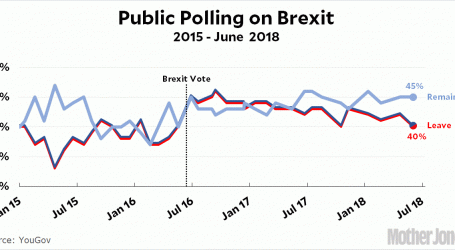“Carbon Bomb” Financiers Threaten World’s Ability to Curb Warming
Richard B. Levine/Zuma
This story was originally published by the Guardian and is reproduced here as part of the Climate Desk collaboration.
Banks pumped more than $150 billion last year into companies whose giant “carbon bomb” projects could destroy the last chance of stopping the planet heating to dangerous levels, the Guardian can reveal.
The carbon bombs—425 extraction projects that can each pump more than one gigaton of carbon dioxide into the atmosphere—cumulatively hold enough coal, oil, and gas to burn through the rapidly dwindling carbon budget four times over. Between 2016 and 2022, banks mainly in the US, China and Europe gave $1.8 trillion in financing to the companies running them, new research shows.
The climate rhetoric did not match up with what was happening on the books, said Shruti Shukla, an energy campaigner at the National Resources Defense Council, which was not involved in the investigation. “We need to rapidly decline our production of fossil fuels and support for fossil fuels, whether that’s regulatory or financial.”
The carbon bombs, which were first identified in an academic database by the Guardian and partners last year, are the single biggest sources of fuels that release planet-heating gas when burned. Data for Good and Éclaircies, two French nonprofits, and several European media outlets have now used publicly available data to map out the companies that operate the carbon bombs and the banks that finance them.
For some projects, the datasets did not match up, were out of date or had an unclear operation status. But the researchers are confident that at least 20 of the 425 have started running since 2020, most of which are coal mines in China, while three projects have been stopped. In total, the researchers estimate that there are now as many as 294 projects running and at least 128 that are yet to start.
Between 2016 and 2022, the research shows, banks in the US alone were responsible for more than half a trillion dollars of finance to companies planning or operating carbon bombs. The single biggest financier was JPMorgan Chase, providing more than $141 billion; followed by Citi, with $119 billion; and Bank of America, with $92 billion. Wells Fargo was the seventh-biggest financier, with $62 billion.
Also in the top 10 were three Chinese banks—ICBC, Bank of China, and Industrial Bank (China)—and three European ones—BNP Paribas, HSBC, and Barclays.
The bulk of the money they provided was general corporate financing to operators, rather than direct loans for projects to dig up fossil fuels. In 2022, direct and indirect financing of carbon bombs came to an estimated $161 billion.
Bringing planned carbon bombs into action would run counter to increasingly stark warnings from doctors, energy experts and climate scientists about the urgent need to swap to cleaner sources of energy.
In 2021 the International Energy Agency found no room for continued expansion of fossil fuel extraction projects in its net zero emissions scenario. A recent Nature study reassessed the amount of fossil fuels that could be burned if realistic levels of carbon dioxide removal are assumed. It found that between 2020 and 2050, the supply of coal must fall by 99 percent, oil by 70 percent, and gas by 84 percent to keep the planet from heating by 1.5 degrees Celsius above preindustrial levels.
If those targets are not met, extreme weather will continue to grow increasingly violent, experts have warned. If they are met, experts said many carbon bombs will become stranded assets that need to be written off, which some fear will shock the financial system.
“If that happens rapidly, we could have another financial crisis,” said Jan Fichtner, a sustainable finance research fellow at the University of Witten-Herdecke, who was not involved in the research. To avoid this, the profitability of oil and gas must be tackled, he added. “In a capitalist system, profitability is the most important current. You can try to swim against the current, it’s possible, but it’s very, very difficult.”
In response to the findings, a JPMorgan Chase spokesperson said: “We provide financing all across the energy sector: supporting energy security, helping clients accelerate their low-carbon transitions and increasing clean energy financing with a target of $1 trillion for green initiatives by 2030. We are taking pragmatic steps to meet our 2030 emission intensity reduction targets in the six sectors that account for the majority of global emissions, while helping the world meet its energy needs securely and affordably.”
A spokesperson for HSBC said: “Supporting the transition to net zero and engaging with clients to help them diversify and decarbonise is a key priority for us. We are working to align our financed emissions to net zero by 2050.”
Barclays said it had set 2030 targets to reduce the emissions it finances in five high-emitting sectors, including energy, where it has achieved a 32 percent reduction since 2020. “Aligned to our ambition to be a net zero bank by 2050, we believe we can make the greatest difference by working with our clients as they transition to a low-carbon business model, reducing their carbon-intensive activity while scaling low-carbon technologies, infrastructure and capacity,” a spokesperson said.
BNP Paribas said that in 2021 it “strongly reinforced” its withdrawal trajectory from fossil fuels and aims to further shift its energy-based financing to 80 percent for low-carbon sources by 2030. A spokesperson said: “BNP Paribas is turning the page on fossil fuels and is focused on mobilising its resources to low-carbon energies. Analyses covering the period between 2016 and 2022 do not reflect the dynamic of BNP Paribas in terms of financing the energy sector. Indeed, BNP Paribas updated in 2023 its oil and gas policy with this engagement: BNP Paribas will no longer provide any financing (loans and bonds) dedicated to the development of new oil and gas fields regardless of the financing methods.”
Wells Fargo, ICBC, Bank of America and Citi declined to comment. Bank of China and Industrial Bank (China) did not respond to a request for comment.
When the Guardian revealed the carbon bombs last year, scientists thought the remaining carbon budget to give a half chance of keeping global heating to 1.5 degrees Celsius was about 500 gigatons of carbon dioxide. But on Monday, leading climate scientists published an update that put the figure at just 250 gigatons. The carbon bombs could release more than 1,000 gigatons over their lifetime.





